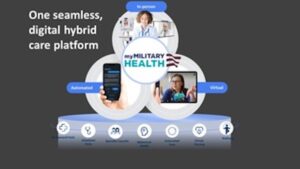
Story by Ken Cornwell
Defense Health Agency
The Defense Health Agency has launched a suite of new digital health care tools at five military hospitals.
Called “My Military Health,” the tools will offer care that is individualized, accessible, and convenient. My Military Health will be accessible 24/7 by computer and mobile devices, will allow patients to schedule appointments, engage with automated clinical support for medical conditions, and use self-help wellness programs.
DHA Director U.S. Army Lt. Gen. Telita Crosland announced the strategic effort at last month’s 2024 annual meeting of AMSUS, The Society of Federal Health Professionals.
“This helps us move beyond traditional models of care that rely primarily on in-person visits,” Crosland said. “The tools will include cutting-edge technologies that strengthen our digital platform and provide a comprehensive blend of self-guided care, real-time and flexible virtual care, and upgraded direct patient care–a model of care that fundamentally changes the experience for patients.”
The five hospitals, referred to as venture sites, are:
• Martin Army Community Hospital, Fort Moore, Georgia
• Naval Hospital Jacksonville, Jacksonville, Florida
• Naval Medical Center Portsmouth, Virginia
• 96th Medical Group, Eglin Air Force Base, Florida
• 88th Medical Group, Wright Patterson Air Force Base, Ohio
Crosland noted that the initial innovations will be targeted to primary care and behavioral health services. “We’re focused on testing new approaches at these sites and not just the technology,” Crosland said. “We will start with the patient first. We’ve got to make health care better and easier to access for our patients. Full stop.”
“Last year, I outlined a vision where patients can better manage their own care and not face a dozen obstacles to get care when they need it,” said Crosland. “On the provider side, a vision of the future is one where physicians, nurses, and medics are liberated by technology rather than burdened by it. A future where the burden of monitoring and entering data for providers and patients is offloaded on devices, and services are connected.”
“We need to have less friction and allow patients to get in the door—and the door does not need to be a physical one. We need an incentive system that makes it easy for medical staff to accommodate patients,” she said. “We need partnerships with industry to adapt to the most current technology and who will help us with our inclination to think virtual first.”
“This is just the beginning,” said Crosland. “We are building something new. We’re not going to be perfect, but we’re going to get better. And then we’re going to keep getting better.”